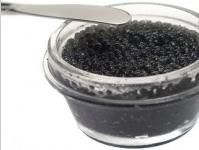 You've seen playboy spies order it while wooing beautiful women. It's been consumed by almost every formal evening wear clad soap opera character on the afternoon airwaves. Michelin ranked chefs use it to garnish a variety of opulent dishes from Wagyu Tartar with Spicy Mayo with Caviar & Garnishes to Shot of Avocado Cold Soup Garnished with Caviar to Warm Oysters with Cucumber & Caviar Butter. The Hollywood elite snack on Deviled Eggs with Caviar at the Academy Awards. Arguably, the most classic way to eat caviar is as an appetizer consisting of a dab of caviar and a dollop of crème fraîche on toast points. If any single ingredient embodies the spirit of the fiscal elite, it's caviar.
You've seen playboy spies order it while wooing beautiful women. It's been consumed by almost every formal evening wear clad soap opera character on the afternoon airwaves. Michelin ranked chefs use it to garnish a variety of opulent dishes from Wagyu Tartar with Spicy Mayo with Caviar & Garnishes to Shot of Avocado Cold Soup Garnished with Caviar to Warm Oysters with Cucumber & Caviar Butter. The Hollywood elite snack on Deviled Eggs with Caviar at the Academy Awards. Arguably, the most classic way to eat caviar is as an appetizer consisting of a dab of caviar and a dollop of crème fraîche on toast points. If any single ingredient embodies the spirit of the fiscal elite, it's caviar.The word caviar originates from the Turkish word khaviar, a variant of the Persian “khaya-dar,” which literally means “having eggs.” While this food has typically been thought of as an upscale delicacy, during the early nineteenth century, caviar was routinely served during free lunches in American saloons as a salty snack which stimulated thirst and enhanced beer sales.
This beer promotion was cost effective due to the fact that America's waters were teaming with sturgeon. In 1873, German immigrant Henry Schacht recognized this resource as being the proverbial gold mine it was, and began exporting caviar to Europe for the then high price of a dollar per pound.
Other entrepreneurs soon followed suit. Much of the harvest shipped to Europe though, was labeled as the more coveted "Russian caviar," and shipped right back to the U.S. at a higher price.
But what is caviar, and why is it thought of as such a luxury food?
First, the term roe is used when referring to eggs harvested from various species of fish. Caviar is a specific kind of roe, the processed salted roe of sturgeon, to be precise. The female sturgeons have to be fully mature and loaded with eggs, 100-200 pounds. The mother's are killed to harvest the eggs which are then hand packed and salted.
As for its expensive price, "real" or "traditional" caviar is only from sturgeon (Beluga, Ossetra, and Sevruga) from Russia and Iran. Mature egg baring sturgeon are extraordinarily rare these days, due to the fact that pollution in the Black and Caspian seas is killing the immature fish. The rarity and hands on preparation both contribute to driving the price of this seafood delicacy up to $114.50 per ounce for Russian Osetra Caviar and $16,000 per kilogram for Beluga Caviar, thought to be the best in the word.
Red caviar, on the other hand, comes from salmon, paddlefish, and/or lumpfish and can be found for as little as $3.50 an ounce. Many of these low end versions though, are dyed with chemical dyes to make them red, and I personally find them to have unpleasantly strong fishy flavors.
Fortunately, entrepreneurs have begun to "farm" sturgeons in the US, China, and Canada, and produce less expensive versions of traditional black caviar. American Hackleback Sturgeon Caviar can be found for around $21.80 per ounce. While still not what the average buyer would call cheap, American sturgeon caviars are more affordable, for special occasions, and deliver the desired salty savory flavor one expects from a caviar. The FEW times I buy caviar, this is the route I like to take.
Thursday, July 18th, 2013 is National Caviar Day. I'm not saying one should take out a loan for an ounce of Beluga in order to celebrate the day. Nevertheless, if you find yourself at your local specialty store, and you come across a moderately priced version of this delicacy, the upcoming observance may be the perfect excuse to try something new
-

No comments:
Post a Comment